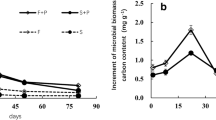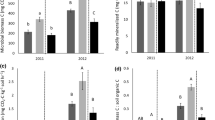Abstract
Previous research shows that nitrogen (N) dynamics, including N starvation, is related to the mineralizable carbon (C) added to the soil. This study was conducted to determine whether the application of mineralizable carbon-rich green waste compost made from pruning materials (PMC) causes soil nitrogen (N) starvation, thus inevitably limiting the plant growth, and how to reduce the negative effect of PMC application on plant growth. Cultivation experiments were conducted to investigate the specific effects of PMC application on plant growth at different application rates and under different soil microbial activities. Forest soil, forest soil and subsoil mixture, subsoil, subsoil and sand mixture, and sand were used in the descending order of microbial activity. Nitrogen (N) starvation was not apparent when PMC compost was applied at ≤ 15% (v/v) to forest topsoil that contained high microbial activity. Conversely, application of PMC compost at ≥ 15% (v/v) to subsoil or sand, each with low microbial activity, resulted in N starvation that continued for approximately 1 year. In soils with high microbial activity, the application of appropriate amounts of PMC promoted plant growth. In soils with low microbial activity, the application of PMC inhibited plant growth in the early stages, but the beneficial effects of PMC application on plant growth were confirmed later. Under any soil microbial activity conditions, soil N starvation disappeared within a year. During the application of PMC to soils with low microbial activity, the effects of nitrogen starvation can be avoided by applying nitrogen fertilizer or fallow for approximately 1 year after application.



Similar content being viewed by others
References
Atiyeh RM, Edwards CA, Subler S, Metzger JD (2001) Pig manure vermicompost as a component of a horticultural bedding plant medium: effects on physicochemical properties and plant growth. Bioresour Technol 78(1)11–20. https://doi.org/10.1016/S0960-8524(00)00172-3
Boldrin A, Christensen TH (2010) Seasonal generation and composition of garden waste in Aarhus (Denmark). Waste Manage Res 30:551–557. https://doi.org/10.1177/0734242x09345275
Boldrin A, Andersen JK, Møller J, Christensen TH, Favoino E (2009) Composting and compost utilization: accounting of greenhouse gases and global warming contributions. Waste Manage Res 27:800–812. https://doi.org/10.1177/0734242x09345275
Cai L, Gong X, Sun X, Li S, Yu X (2018) Comparison of chemical and microbiological changes during the aerobic composting and vermicomposting of green waste. PLoS ONE 13:e0207494. https://doi.org/10.1371/journal.pone.0207494
Cambardella CA, Richard TL, Russell A (2003) Compost mineralization in soil as a function of composting process conditions. Eur J Soil Biol 39:117–127. https://doi.org/10.1016/s1164-5563(03)00027-x
Dempster DN, Gleeson DB, Solaiman ZM, Jones DL, Murphy DV (2012) Decreased soil microbial biomass and N mineralisation with Eucalyptus biochar addition to a coarse textured soil. Plant Soil 354:311–324. https://doi.org/10.1007/s11104-011-1067-5
Eo J, Park K-C (2013) Effects of manure composts on soil biota and root-rot disease incidence of ginseng (Panax ginseng). Appl Soil Ecol 71:58–64
Fujiwara N, Yamagishi Y, Tanaka T, Niijima K, Nakai K (2003) Influence of pruning upon carbon dioxide fixation with urban greening. Journal of the Japanese Society of Revegetation Technology 29:45–50 (in Japanese). https://doi.org/10.7211/jjsrt.29.45
He ZL, Alva AK, Yan P, Li YC, Calvert DV, Stoffella PJ, Banks DJ (2000) Nitrogen mineralization and transformation from composts and biosolids during field incubation in a sandy soil. Soil Sci 165:161–169. https://doi.org/10.1097/00010694-200002000-00007
Hobbie SE (2015) Plant species effects on nutrient cycling: revisiting litter feedbacks. Trends Ecol Evol 30:357–363. https://doi.org/10.1016/j.tree.2015.03.015
Ichikawa T, Ichikawa A, Urakwa R (2008) A simple method of measuring of microbial activities in organic matter using a FDA (fluorescein diacetate) hydrolysis. Japanese Society of Forest Environment 50:175–177 (in Japanese). https://doi.org/10.18922/jjfe.50.2_175
Lal R (2009) Challenges and opportunities in soil organic matter research. Eur J Soil Sci 60:158–169. https://doi.org/10.1111/j.1365-2389.2008.01114.x
Liu E, Takahashi T (2019) Carbon mineralization characteristics of compost made from pruning material. Landsc Ecol Eng 15:199–204. https://doi.org/10.1007/s11355-018-00369-0
Liu E, Terumasa T, Caixia L (2016) The effect of compost made from pruning materials and traditional compost on soil chemical properties. For Environ Sci 32:68–72 (in Chinese). https://doi.org/10.3969/j.issn.1006-4427.2016.02.013
Liu E, Takahashi T, Hitomi T (2019) Effect of pruning material compost on the nitrogen dynamic, soil microbial biomass, and plant biomass in different soil types. Landsc Ecol Eng 15:413–419. https://doi.org/10.1007/s11355-019-00392-9
López-González JA, Suárez-Estrella F, Vargas-García MC, López MJ, Jurado MM, Moreno J (2015) Dynamics of bacterial microbiota during lignocellulosic waste composting: studies upon its structure, functionality and biodiversity. Bioresour Technol 175:406–416. https://doi.org/10.1016/j.biortech.2014.10.123
Nawawi DS, Syafii W, Akiyama T, Matsumoto Y (2016) Characteristics of guaiacyl-syringyl lignin in reaction wood in the gymnosperm Gnetum gnemon L. Holzforschung 70:593–602
Oldeman LR (1994) The global extent of soil degradation. In: Greenland DJ, Szabolcs I (eds) Soil resilience and sustainable land Use. CAB International, Wallingford, pp 99–118
Riffaldi R, Saviozzi A, Levi-Minzi R (1996) Carbon mineralization kinetics as influenced by soil properties. Biol Fertil Soils 22:293–298. https://doi.org/10.1007/s003740050114
Smith J, Papendick R, Bezdicek D, Lynch J (1993) Soil organic matter dynamics and crop residue management Soil microbial ecology. Marcel Dekker, New York, pp 65–95. https://doi.org/10.1016/s0929-1393(97)00032-2
Takahashi T, Iizumi K, Hirano M, Hirano Y, Matsuda H (2009) Soil improvement by mixing with woody compost in crop land. Journal of the Japanese Society of Revegetation Technology 35:194–197 (In Japanese). https://doi.org/10.7211/jjsrt.35.194
Takahashi T, Kanbara D, Ishii M, Ogino J, Harada H, Yairo H, Yamada T, Torigoe A (2014) Estimation of C dynamics in decomposition of pruning material. Landsc Res Jpn Online 7:17–19 (in Japanese). https://doi.org/10.5632/jilaonline.7.17
Termorshuizen AJ, van Rijn E, van der Gaag DJ, Alabouvette C, Chen Y, Lagerlöf J, Malandrakis AA, Paplomatas EJ, Rämert B, Ryckeboer J, Steinberg C, Zmora-Nahum S (2006) Suppressiveness of 18 composts against 7 pathosystems: variability in pathogen response. Soil Biol Biochem 38:2461–2477. https://doi.org/10.1016/j.soilbio.2006.03.002
Wang F, Chen C (2007) Current status of soil and plant nutrient management in China and improvement strategies. Chin Bull Bot 24:687 (In Chinese). https://doi.org/10.3969/j.issn.1674-3466.2007.06.001
Zhang L, Sun X, Tian Y, Gong X (2013) Effects of brown sugar and calcium superphosphate on the secondary fermentation of green waste. Bioresour Technol 131:68–75. https://doi.org/10.1016/j.biortech.2012.10.059
Zimmerman AR, Gao B, Ahn MY (2011) Positive and negative C mineralization priming effects among a variety of biochar-amended soils. Soil Biol Biochem 43:1169–1179. https://doi.org/10.1016/j.soilbio.2011.02.005
Acknowledgements
We would like to thank the Agora Landscape Architecture Corporation for providing PMC compost. We would like to acknowledge the professional support provided by Prof. Tatsuaki Kobayashi and Akira Kato of Chiba University for their advice. We are also thankful to Mr. Hitomi Takuya for his assistance during the experiment. The experiments comply with the current laws of the country in which they were performed.
Author information
Authors and Affiliations
Corresponding author
Ethics declarations
Conflict of interest
The authors declare no competing interests.
Additional information
Publisher's Note
Springer Nature remains neutral with regard to jurisdictional claims in published maps and institutional affiliations.
Rights and permissions
About this article
Cite this article
Liu, E., Terumasa, T. Effects of Applying Recycled Urban Green Waste Compost Made from Pruning Materials to Soil on the Growth of Plants. J Soil Sci Plant Nutr 22, 1088–1097 (2022). https://doi.org/10.1007/s42729-021-00717-4
Received:
Accepted:
Published:
Issue Date:
DOI: https://doi.org/10.1007/s42729-021-00717-4




